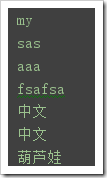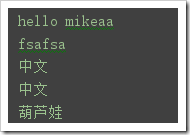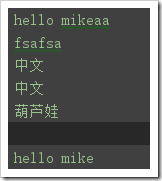本文实例讲述了Python打开文件、文件读写操作、with方式、文件常用函数。分享给大家供大家参考,具体如下:
打开文件:
在python3中,打开文件的函数是:
|
1
|
<strong>open(file, mode='r', buffering=None, encoding=None, errors=None, newline=None, closefd=True)</strong> |
参数说明:
|
1
|
file--文件名 |
|
1
|
mode—打开模式,默认只读模式 |
|
1
|
buffering--如果buffering的值被设为0,就不会有寄存。如果buffering的值取1,访问文件时会寄存行。如果将buffering的值设为大于1的整数,表明了这就是的寄存区的缓冲大小。如果取负值,寄存区的缓冲大小则为系统默认。 |
|
1
|
encoding—打开文件的编码方式 |
模式介绍:
r:只读模式(默认)
w :只写模式,如果文件不存在就创建,如果存在,写入的数据会覆盖原来的数据
b :二进制模式
t :文本模式
+:可写可读模式
a:追加模式,如果文件存在则文件指针指向文件末尾(追加数据),如果不存在就创建
r+:读追加模式,先读,再追加
w+:写读模式,先写,意味着原本内容丢失,再读。
- 如果对于含有非ascll字符的文件,必须使用encoding,否则会抛异常:

|
1
2
3
4
5
6
7
8
9
10
11
12
13
|
print("r".center(50,'-'))f=open("file.txt",encoding="utf-8")print(f.read())f.close()-----------------运行结果:mysasaaafsafsa中文中文葫芦娃 |
文件使用完毕后必须关闭: 文件指针.close()
文件操作:
读操作:
读取文件内容如下:

- reads()是读出全部内容
|
1
2
3
4
5
6
7
8
9
10
11
12
13
|
print("r".center(50,'-'))f=open("file.txt",encoding="utf-8")print(f.read())f.close()---------------------------运行结果:mysasaaafsafsa中文中文葫芦娃 |
- readline()是读出一行
|
1
2
3
4
5
6
7
8
|
print("r".center(50,'-'))f=open("file.txt",encoding="utf-8")print(f.readline())f.close()-----------运行结果:my |
- readlines()是读出全部内容,并整理成一个列表
|
1
2
3
4
5
6
7
8
9
10
11
|
print("r".center(50,'-'))f=open("file.txt",encoding="utf-8")print(f.readlines())f.close()#------------------------r-------------------------#运行结果:['my\n', 'sas\n', 'aaa\n', 'fsafsa\n', '中文\n', '中文\n', '葫芦娃\n', '\n'] |
- r+模式会根据读的内容来决定指针的位置
|
1
2
3
4
5
|
print("r".center(50,'-'))f=open("file.txt","r+",encoding="utf-8")# print(f.readline())f.write("hello mike")f.close() |
结果:

|
1
2
3
4
5
|
print("r".center(50,'-'))f=open("file.txt","r+",encoding="utf-8")print(f.readline())f.write("hello mike")f.close() |
新结果:

写操作:
- write():将一个字符串写入文件
|
1
2
3
4
|
myfile=open("myfile1","wb")myfile.write(b"nnnnnn")myfile.write("my葫芦娃".encode("utf-8"))myfile.close() |
- writelines(可迭代对象) 将一个可迭代对象写入文件
|
1
2
3
4
5
|
myfile=open("myfile1","wb")myfile.write(b"nnnnnn")myfile.writelines([b'1',b'2',b'3',b'4'])myfile.close() |
- 当需要写完之后即时读出来时,使用w+,然后将文件指针置回文件头:
|
1
2
3
4
5
|
myfile=open("myfile1","wb+")myfile.write(b"nnnnnn")myfile.seek(0)print(myfile.read())myfile.close() |
-
-
- 如果是需要读出特定位置,可以使用变量来记录位置
-
|
1
2
3
4
5
6
7
|
myfile=open("myfile1","wb+")myfile.write(b"1nnnnnn")site=myfile.tell()myfile.write(b"2nnnnnn")myfile.seek(site)##读出后一段print(myfile.read())myfile.close() |
with:
- 为了便捷的关闭文件,python增加了with功能,当with体执行完将自动关闭打开的文件:
|
1
2
3
4
5
|
with open("file.txt","r+",encoding="utf-8") as f:##将自动执行f.close() print(f.tell()) f.write("金刚") for line in f: print(line,end="") |
- 可以同时打开多个文件:
|
1
2
3
|
with open("file.txt",'r') as f ,\open("file.new",'r') as m: print(f.read(),m.read()) |
文件常用函数:
file.close():关闭文件。关闭后文件不能再进行读写操作
file.seek(offset[, whence]):设置文件当前位置
file.tell():返回文件当前位置。
|
1
2
3
4
5
6
7
|
myfile=open("myfile1","wb+")myfile.write(b"1nnnnnn")site=myfile.tell()myfile.write(b"2nnnnnn")myfile.seek(site)##读出后一段print(myfile.read())myfile.close() |
file.flush():刷新文件内部缓冲,立即把内部缓冲区的数据写入文件,因为并不是马上将文件
|
1
2
3
4
5
6
7
|
import timemyfile=open("myfile1","wb+")myfile.write(b"1nnnnnn")time.sleep(10)# myfile.flush()myfile.write(b"2nnnnnn")myfile.close() |
上述代码,直到程序运行完成才一次性写入“1nnnnnn2nnnnnn”
|
1
2
3
4
5
6
7
|
import timemyfile=open("myfile1","wb+")myfile.write(b"1nnnnnn")myfile.flush()time.sleep(10)myfile.write(b"2nnnnnn")myfile.close() |
上述代码,可以看到,在程序sleep之前就已经写入了“1nnnnnn”
file.truncate([size]):截取文件,从文件开头,截到指定位置,会覆盖原文件。
文件内容:

|
1
2
3
4
5
6
7
8
9
|
print("r".center(50,'-'))f=open("file.txt","r+",encoding="utf-8")print(f.readline())print("----truncate()-------")print(f.tell())m=f.tell()f.truncate(m)#内容从0位置截断到指定位置,不论当前光标位置f.close() |
执行后,文件内容:

希望本文所述对大家Python程序设计有所帮助。
原文链接:https://www.cnblogs.com/progor/p/8412953.html










